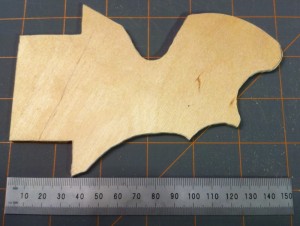The Interlude and the Scroll Saw
I got a small scroll saw: small hobby size, nothing huge, nothing fancy. It fits on the workbench, with a nominal 16″ throat depth. It’s from Craftsman, got reasonably good reviews: in fact, from my combing and reading, about the best of anything in its general price class (I was not in the market for a $500 DeWalt saw [harumph!]). With the saw’s arrival, I thought it would be fun to take some parts I already had in the Rocketworks (“project fodder”), design some odd-shaped fin, and build a rocket.
Besides, I needed something to occupy my time productively while awaiting parts for BAAH-1.
As the project evolved, it’s become a good proving grounds for some of the detailed construction techniques I’ll use in BAAH-1: for example, securing the middle rail button when it’s between two centering rings from the motor mount. And, as it evolved and I got a better sense of the shape of the fins, it acquired a real name—along with a paint scheme.
Meet the first piece of Die Fledermaus.
Not all was sweetness and cream, though. Part way through the project, it seemed as if my saw had broken. It’s not that it was in pieces, but it stopped working correctly after I changed the blade. I had changed blades before, so I could not, at first, figure out what had gone wrong. The problem was that the saw’s upper arm was whacking the underside of its housing at the top of the up-stroke, something that, pretty clearly, was not a good thing.
I searched. I searched some more. I checked the manual, tried innumerable online queries in the search engines, and came up with nothing to give me a solid hint as to what was wrong. Finally, I stumbled on something: a suggestion from an experienced scroll sawyer that the tension knob, used to adjust the tension on the blade, can come completely out of its receiving nut (or threaded fixture). I found this just before I was going to throw in yon towel and endure the travails of calling Craftsman Tech Support.
Upon removing the tension knob, I found that the specific tip provided by that experienced scroll sawyer did not apply to my saw. I fiddled with the mechanism, moving the actuating cam-arm, watching how things moved, and trying to figure this out without taking apart the entire upper portion of the saw—or more. I discovered that the tension knob’s mechanism seemed to raise and lower the upper arm: the upper arm, when under any tension (even a small amount), moved in conjunction with the lower arm. This made sense: the two arms wave up and down together, holding the blade between them. As I tightened the tension knob, the upper arm pivoted up—and up—and up.
Maybe I had just tightened the tension knob too far!
I loosened the tension knob, re-inserted the blade, tightened the knob back to what seemed a good tension, and hit the power switch.
Voilà!
